Texting at Work and Social Media Distractions Cost Businesses Billions
How many times each day are you distracted by text messages, instant messages, social media or emails? How many times do you see your work colleagues texting away on their mobile devices? How much time is being wasted by this? Are your work colleagues continuously distracted at meetings by looking at text messages? Is this fair and equitable and proper work etiquette?
Private texting at work is insidious and hard for management to stop because its silent. Most companies have banned private email at work, with all email traffic being monitored, but many allow texting at work without any controls or restrictions.
Many companies have also restricted private phone calls at work to lunch times and tea breaks. But no such controls can be imposed on texting as employees silently use their own personal devices at their desks. The culture of texting assumes that its OK to text anytime and anywhere.
Texting can also be hazardous for hands and thumbs with potential risks of claims for compensation for work related injuries.
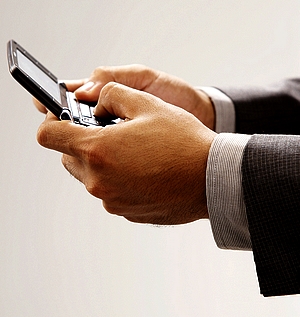
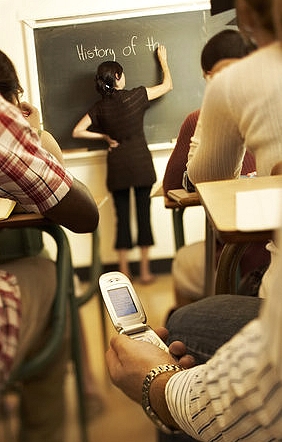
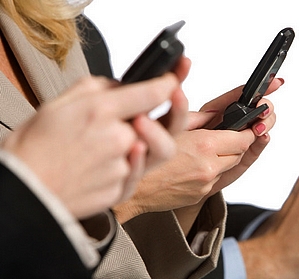
Ironically information technology, which heralded great advances in productivity and time saving, is actually doing the exact opposite. It may even be changing the way young people think and destroying their attention spans.
The very tools we now rely on to do our jobs are lowering our performance by distracting us. Psychologists are warning of the risk of ‘online compulsive disorder’ can extend from our personal lives to work. What is the size of the problem and how can companies impose rules for texting at work?
This article discusses these issues and outlines an approach for developing private cell phone policies, with an example or such a policy.
Quantifying the Size of the Problem
A survey of about 500 people employed by businesses in the U.S. estimated that companies with greater than 1,000 employees, lost $10 million each year through decreased productivity caused by various types of digital distractions such as text messaging, social networks or private emails.
About 50% of the employees admitted that they only worked for an average of 15 minute spans before getting interrupted or distracted. About half of them admitted that they wasted an hour or more a day directly on these distractions.
The effect on work productivity is probably two or three times the actual time spent reading and responding to messages. People think about messages they have received, plan responses and wait for replies to ongoing conversations. The stream of messages has also been shown to degrade people's ability to think deeply about work-related issues and creatively solve problems. Distracted people become inefficient in processing information and in meeting deadlines.
The relative proportion of digital distractions in the survey were:
- Web search: 3%
- Instant messaging and texting: 11%
- Personal online activities such as Facebook: 9%
- Switching windows to complete tasks: 10%
- Email processing: 23%
The entry of generation Y into the workforce is probably gong to increase these problems as texting is highly prevalent in young people, particularly teenagers, and people in their early twenties. Other researchers have noticed that young employees know very little about emails and hardly use them.
Some companies have begun switching off their email systems because young people cannot adapt to it and most of it is irrelevant bulletins. Many companies ban or restrict personal emails at work and so the actual size of the texting distractions is probably much higher than the figures above suggest. The older employees are catching the texting bug from the younger generations and its becoming increasingly popular.
The culture of texting is all persuasive - text messages can be received and replied to anytime anywhere. I have even seen member of panels being interviewed on TV shows texting away quite publicly during the program. They were obviously distracted, much to the annoyance of the host. This typifies the attitude problem.
The Problem is Worse with the Social Savvy Younger Generation
About 50% of the 250 college students surveyed for another research study stated that they spent 1-4 hours (average 2 hours) a day text messaging, with some talking on their cell phones as well. One student was renowned for texting 700 messages per week (100 a day). Additionally, about 40% of the students said they also spent another two hours a day on Twitter, Facebook and similar social networking sites.
Another study found that more than 75% of teenagers have a cell phone and about 90% of teenagers who have cell phone users are texters. More than 30% of the teens reported sending more than 100 messages per day (6 per walking hour, 1 message every 10 minutes), and about 15% reported sending more than 200 texts a day (12 per walking hour, 1 message every 5 minutes) Many teenagers sleep with their smartphones under their pillow so their sleep is disturbed.
The constant distractions could have serious consequences when young people enter the workforce. Researchers have warned that developing brains may become adapted to constantly switching tasks and kids may become less able to sustain attention spans. The concern is that kids raised in front of screens will have brains that are wired differently and will not be able to remain focused on delivering tasks at work or even at school or college.
Issues for Developing Private Cellphone Use and Texting Policies
Whether employees should take personal calls while working has always been a contentious issue. It is understandable that a family member or friend could need to contact an employee in the event of an emergency or for various other personal reasons, such as picking kits up from school, late buses etc. However, common sense is required when receiving and making such calls to kept them to a minimum. It is acceptable for employees to make or receive urgent calls. The employee should step out of the office and keep the conversation short or deal with them during lunch and tea breaks if not urgent. The same principles should apply to texting. If employees must receive or reply to text messages, keep them short and to the point. If employees are receiving non-urgent text messages from friends, they should consider waiting to reply during breaks. An immediate and instant response is not necessary most of the time.
Employees should consider turning off their phones under the following situations:
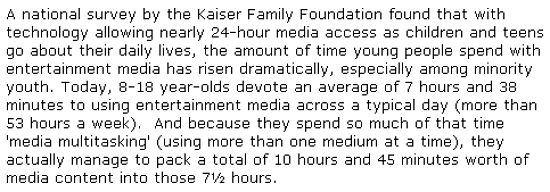
- when interacting with a customer or fellow employee - this should be the priority not the interruption
- when offering customer service over the phone
- during meetings and discussions
- when working with the public
Customers and your colleagues deserve 100% of your attention - it is a matter of mutual respect.
Creating a Cell Phone Policy
1. Who to Consult When Crafting a Cellphone Policy
To craft a policy start with the managers and human resource staff with the involvement of the IT staff. It's also worth consulting your legal team.
Basic questions to consider:
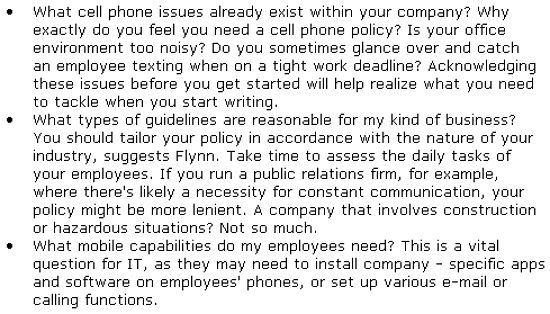
General Cell Phone Etiquette
There as some basic rules of phone etiquette that need to be considered. Most of these rules are common sense, but it is commonly accepted that personal texting calls are OK anytime, anywhere.
These etiquette guide should apply for both company and personal cell phones
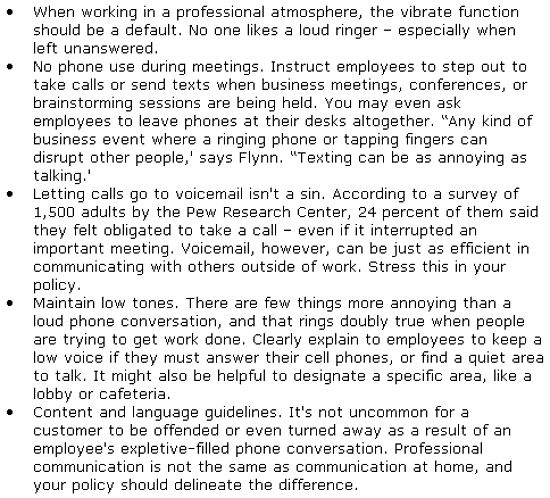
A sample policy is shown below that you may find useful in developing your own policy.
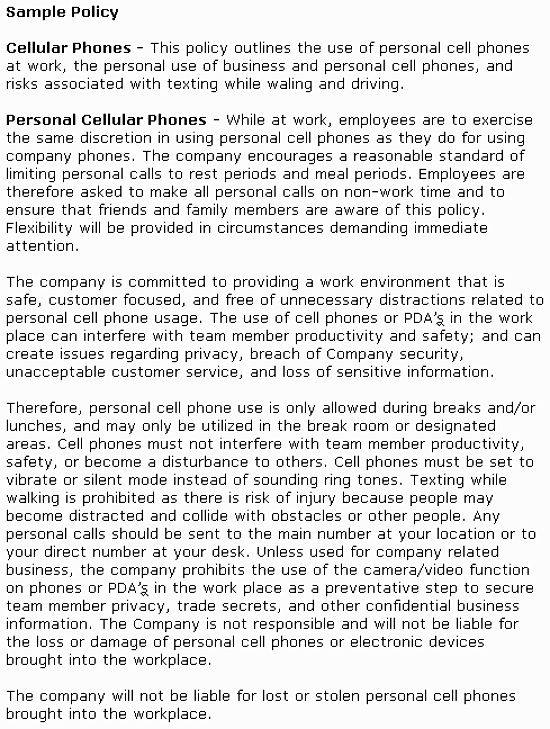
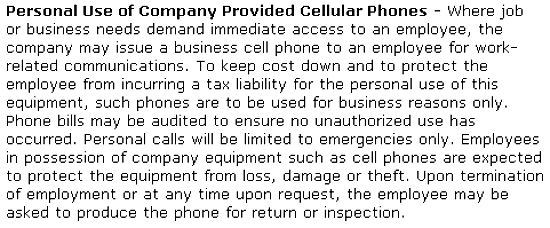
Disclaimer:& This article is only a guide and there is no responsibility for its use in part or whole.